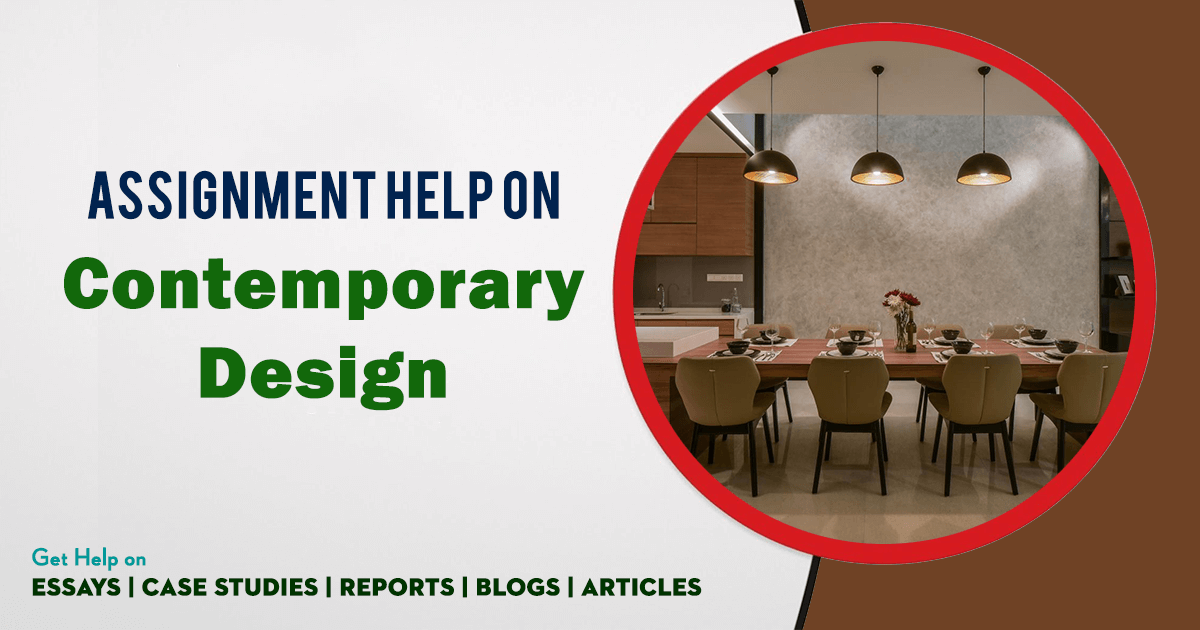Contemporary Design | Assignment Help
Contemporary Design
In last few years the world of Contemporary Design has undergone some massive changes, people are more passionate about what materials they use, how quality of products can can be improved and how can existing products can be reused. Increasing interest in shortening time between concept and market for new products has highlighted the need for working with overlapping activities designs using new materials, with which designers around the world are getting themselves familiarize. According to Krishnan et al. (1997)[1], overlapping product development activities can help firms to develop products more quickly and with better quality as well.

Over the past few years, a rapid growth has been noticed in the design sector. People are now considering designs as their daily routine activity rather than studies either in the field of for example, fashion, architecture or packaging design (Lee. Y 2007)[2]. Various organizations across the globe are finding new ways to use existing products in the development of new and creative designs.
However the real question is why in the field of art, many professionals and artists are willing to compromise and settle for something which can hardly be categorized as art. Many artists and designers believe that with the help of design they can voice directly to the public regardless of language, culture or beliefs (Mau. B)[3]. To be able to do so, creativity serves a very important role in culture, education, and the workforce as it “provides the impetus for any act, idea or product that changes an existing domain or discipline into a new activity” (Csikszentmihalyi, 1996, p. 28)[4]. The 21st century is playing its a major role, where information technology is forming a powerful alliance with creative practices in the field of design and creativity in order to establish new domains in information technology and other creative practices.
According to Mau. B, 2004, “In living with contemporary information technology, more and more people regardless of their culture and language are becoming active participants and co-creators with other firms”. At the same time, technological processes, tools, and interfaces rekindle an interest in creativity and its expression. Various organizations and firms are using new materials that can be altered for the purpose of designing and other creative endeavors (Lee. Y, 2007). The materials that a product is made of influences how users interact with it. Many design oriented studies have been undertaken with the help of science and technology to analyze which product design and material selection processes are superior when compared to others. When people interact with various products that are in their daily routine use, their senses are connected with the materials used in those products.
According to Ball. P 1997, research in the fields of materials and packaging design is getting more and more developed, as people are showing more interest in such fields. With the help of science and other latest technologies, many companies are constantly trying to use existing products in new designs. However the biggest argument is whether products play a role in the development of new designs, where new materials not only provide technical qualities to products, but also impact on the way users can interact with the products. According to Ball. P, 1997, IT and other engineering firms are working towards the designing of the molecular world, that has its further connections with chemistry, biology, and physics. Many product designers around the world use various materials to create new designs to meet the needs of people around the world. (Ball P, 1997). Any new product regardless of its design is usually appreciated through the use of its materials, which can be considered as part of the product’s interface. There are several models that exist which can be used to describe the materials selection process. Two of the most common material selection processes are Preliminary model and Reworked model. (Lee. Y, 2007). Every year when hundreds of new products are launched in the market, it quickly becomes evident that how important new materials are. New innovations from the latest touch screen mobile phones to high-tech comforters and furniture, would not be possible without new materials (Gibson. K)[5] In the early design phase, it is not all necessary to fully know the relevant details of the selected material options. Even products that already exist in the market can be preferred when the materials used are stronger, more compact, smarter, and in some cases cheaper.

The concept of designs using new materials is, a knowledge-intensive work that has become increasingly important in today’s globally competitive environment. Designs using new materials are a key strategic activity in many firms because new products contribute towards the sales revenue and profit.
Product design is a critical factor in organizational success as it helps in setting the characteristics, features and other performance of the service or good that consumer’s desire. In today’s global market, product design has become more important than ever because customers are demanding greater product variety and are switching more quickly to products with state-of-the art technology. According to Gibson K, product design is generally considered as an essential activity for firms competing in global environments. Companies and organizations involved in contemporary interior design using new materials and technology are typically successful as it ultimately meets the needs of consumers.
Customers are constantly demanding greater product differentiation on the regular basis and in order to meet such challenging demands new materials are being. Further programs and activities are being put in place so organizations can cope with these dimensions (Kodama. F)[6]. On regular basis, organizations are embracing concepts such as mass customization, design for manufacturing and assembly efficiency and end of product-life disposal.
If freedom is provided to designers in their fields, such freedom can act as one of the most important and extremely significant factor for producing parts of complex geometry that could result in reducing the lead time and ultimately the overall manufacturing costs for such products (Hague et al. 2001)[7]. The overall efficiency of the materials selection process for product designers depends on a clear and usable view about the required material properties. The total time required to design a product can be reduced by using various new materials and by using a team approach including early involvement of key participants in departments such as marketing, research and development, engineering and operations. From apparel to aerospace, steel to software, the pace of technological innovation is quickening, companies can no longer afford to miss any gap of generation of technology (Reinertsen, D.G)[8]. Innovation are increasingly crossing industry boundaries, at the same time many companies have adapted new technologies to create new products to transform markets.



